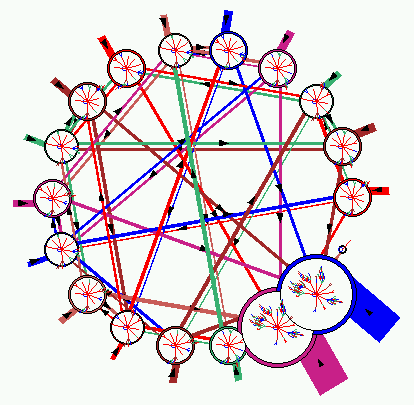 Discrete Dynamics Lab
Discrete Dynamics Lab
The DDLab Manual - Preface and Contents - July 2001
The illustrated DDLab manual (421 pages, 209 figures)
for binary CA and RBN, corresponds exactly to DDLab Version 24, released in 2002.
This page gives the Contents (chapter headings only),
Preface, and Acknowledgments,
with links to versions of the first 4 chapters (without figures).
The new multi-value manual (work in progress, not described here) corresponds to
the latest version of DDLab.
The manuals are available in pdf format at ...
Contents

Preface
Acknowledgments
Contents
List of Figures
List of Tables
- Introduction
-
Summary of DDLab functions
- Accessing DDLab
- Quick Start Examples
- Starting DDLab
- The first prompt in DDLab
- Network size, 1d
- Neighborhood, k, or mixed k
- The local neighborhood, and network geometry
- Setting the wiring, quick settings
- Setting special wiring
- Rules
- Rule-mix options
- Specify a subset of rules
- Setting Canalization in a random rule-mix
- Setting a singe rule
- Reviewing network architecture
- Transforming network rules
- Save/load/print network architecture
- The network graph, and attractor meta-graph
- The Seed or initial state
- The Derrida plot
- Graphic conventions for attractor basins
- Output parameters for attractor basins
- Layout of attractor basins
- Display of attractor basins
- Pausing attractor basins, and data
- Mutation of attractor basins
- Final options for attractor basins
- Drawing attractor basins, and changes on-the-fly
- Output parameters for space-time patterns
- Drawing space-time patterns, and changes on-the-fly
- Classifying rule space
- Learning, forgetting, and highlighting
- Filing
Bibliography
Index
Networks of sparsely inter-connected elements having discrete values
and updating in discrete time (in parallel or sequentially) are
central to a wide range of natural and artificial phenomena drawn
from many areas of science; from physics to biology to cognition; to
social and economic organization; to parallel computation and
artificial life; to complex systems in general.
Such ``decision making'' networks are increasingly applied as
idealized models, especially in the study of complexity and emergence,
and in the behavior of networks in general, including
neural and gene networks. In addition, the networks themselves have
intrinsic interest as mathematical/physical systems with a large
body of literature devoted to their study. Because the dynamics is
difficult to describe by classical mathematics, computer simulation
is required, and there is a need for simulation software for
non-experts in programming to model networks in their particular
fields.
DDLab is an interactive graphics program aimed at addressing these
issues, widely used in both research and education. The
dynamics of a wide range of finite binary networks may be
investigated, from Cellular Automata to Random Boolean Networks and
beyond.
As well as generating space-time patterns in one, two or three
dimensions, DDLab constructs attractor basins, graphs that link
network states according to their transitions, representing
``global'' dynamics, analogous to the phase portrait in continuous
dynamical systems. The graphs, consisting of trees rooted on
attractor cycles, reveal the network's ``memory'', how the network
hierarchically categorizes state space. Learning and ``inverse
problem'' algorithms are included that seek to reconstruct a network
that satisfies a given set of transitions.
DDLab is an applications program, it does not require writing code.
Network parameters and the graphics presentation can be flexibly
set, reviewed and altered, including changes "on the fly". A wide
variety of measures, data, analysis and statistics are available.
This manual provides a comprehensive guide.
Many people have influenced DDLab by contributing ideas, suggesting
new features, providing encouragement, criticism, and helping with
programming. I reserve all the blame for its shortcomings. I would
like to thank Mike Lesser, Grant Warrel, Crayton Walker, Chris
Langton, Stuart Kauffman, Wentian Li, Pedro de Oliviera, Inman Harvey,
Phil Husbands, Guillaume Barreau, Josh Smith, Raja Das, Christian
Reidys, Brosl Hasslacher, Steve Harris, Simon Frazer, Burt Voorhees,
John Myers, Roland Somogyi, Andrew Adamatzky, Mark Tilden, Rodney
Douglas, Terry Bossomaier, Ed Coxon, Oskar Itzinger, Pietro diFenizio,
Pau Fernandez, Ricard Sole, and many other friends and colleagues (to
whom I apologize for not listing). Also DDLab users, and researchers and
staff at the Santa Fe Institute since the spring of 1990,
when I first turned up there summoned by Stuart Kauffman.
back to the start
back to the DDLab home page
Last modified: July 2003


